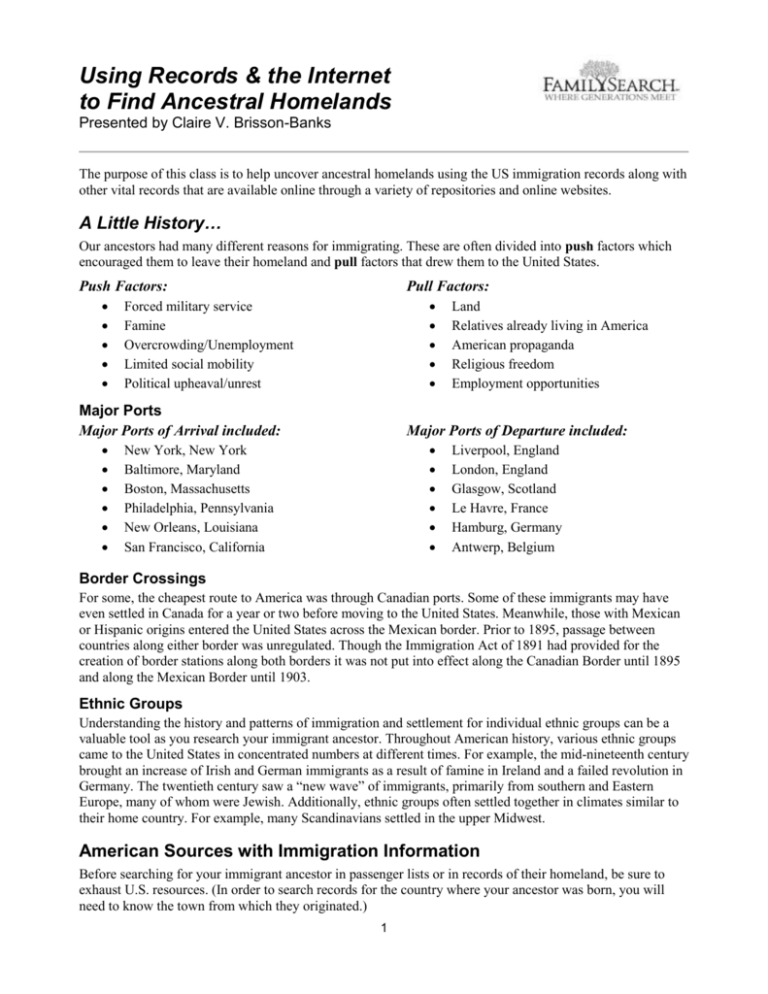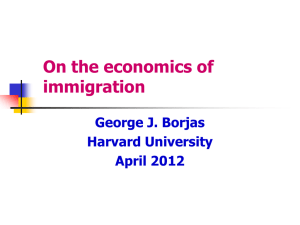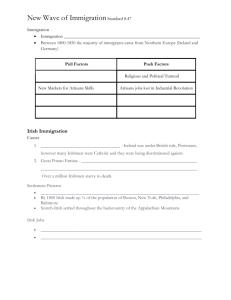
Using Records & the Internet
to Find Ancestral Homelands
Presented by Claire V. Brisson-Banks
The purpose of this class is to help uncover ancestral homelands using the US immigration records along with
other vital records that are available online through a variety of repositories and online websites.
A Little History…
Our ancestors had many different reasons for immigrating. These are often divided into push factors which
encouraged them to leave their homeland and pull factors that drew them to the United States.
Push Factors:
Pull Factors:
Forced military service
Famine
Overcrowding/Unemployment
Limited social mobility
Political upheaval/unrest
Major Ports
Major Ports of Arrival included:
Land
Relatives already living in America
American propaganda
Religious freedom
Employment opportunities
Major Ports of Departure included:
New York, New York
Baltimore, Maryland
Boston, Massachusetts
Philadelphia, Pennsylvania
New Orleans, Louisiana
San Francisco, California
Liverpool, England
London, England
Glasgow, Scotland
Le Havre, France
Hamburg, Germany
Antwerp, Belgium
Border Crossings
For some, the cheapest route to America was through Canadian ports. Some of these immigrants may have
even settled in Canada for a year or two before moving to the United States. Meanwhile, those with Mexican
or Hispanic origins entered the United States across the Mexican border. Prior to 1895, passage between
countries along either border was unregulated. Though the Immigration Act of 1891 had provided for the
creation of border stations along both borders it was not put into effect along the Canadian Border until 1895
and along the Mexican Border until 1903.
Ethnic Groups
Understanding the history and patterns of immigration and settlement for individual ethnic groups can be a
valuable tool as you research your immigrant ancestor. Throughout American history, various ethnic groups
came to the United States in concentrated numbers at different times. For example, the mid-nineteenth century
brought an increase of Irish and German immigrants as a result of famine in Ireland and a failed revolution in
Germany. The twentieth century saw a “new wave” of immigrants, primarily from southern and Eastern
Europe, many of whom were Jewish. Additionally, ethnic groups often settled together in climates similar to
their home country. For example, many Scandinavians settled in the upper Midwest.
American Sources with Immigration Information
Before searching for your immigrant ancestor in passenger lists or in records of their homeland, be sure to
exhaust U.S. resources. (In order to search records for the country where your ancestor was born, you will
need to know the town from which they originated.)
1
Privately Held Records
Information about where your immigrant ancestor came from, when he or she came to the United States, or
even when he or she naturalized may be found in privately held records. Family letters, bibles, pictures, and
papers are valued memories of those who immigrated to America and are often closely guarded and carefully
handed down from one generation to another. If you did not inherit the precious family artifacts, you may
need to track down relatives to get access to the records of your immigrant ancestor. They may have the very
thing you need to trace your ancestor across the ocean.
Census Records
Census records contain important clues about immigration (country of origin and date of immigration) and
naturalization. Make sure to find your ancestor in every available census and read each column carefully.
The 1850 census was the first census to ask for place of birth.
The 1880 census was the first census to ask for place of birth for both father and mother.
The 1900-1930 censuses asked for immigration information including year of immigration (19001930), number years in the U.S. (1900), whether naturalized (1900-1930), and year of naturalization
(1920).
The 1910 and 1920 censuses asked for the native tongue of the respondent. The 1920 Census included
the native tongue of the respondent’s parents (useful when determining which part of an Eastern
European country an immigrant originated from).
Other Records
Vital Records: Though vital records were not recorded in most states until the latter half of the nineteenth
century, many provide information about an individual’s date and place of birth. An immigrant’s marriage
record, death record, and their children’s birth and death records may include the name of the town from
which your ancestor originated.
Obituaries: Obituaries, especially those published prior to or during the twentieth century, may also include
immigration information such as place of birth, date of immigration, or name of ship. A high percentage has
been microfilmed over the years; however, there are online subscription sites like GenealogyBank.com,
NewspaperArchives.com, Google News and Archive Search along with others.
Church Records: For many immigrants, one of the strongest ties to the old world and the culture they left
behind was through their religion. Ecclesiastical leaders often noted a town of origin when recording
marriages, deaths, and even the births of children. Other individuals belonging to same religious community
may also have emigrated from the same location.
County Histories: County histories may provide clues as to where a large community of immigrants
originated. County histories often include biographical sketches of prominent members of the community and
may include immigration information. Sketches of children and grandchildren may also contain information
about their immigrant parents or grandparents. Many county histories are located in local libraries and various
historical and genealogical societies throughout the world.
Naturalization Records
Naturalization is the process whereby an alien becomes a citizen. In the United States, naturalizations date
from 1790. Three sets of papers were usually created during the naturalization process: Declaration of
Intentions, Petition for Naturalizations, and Naturalization Certificates. The declaration of intention often
includes the most information of genealogical value. Prior to 1906, declarations required that applicants list
only their country of origin. After 1906, applicants were required to list their place of birth. For more
information on U.S. naturalization law as well as how to locate records, see
https://wiki.familysearch.org/en/United_States_Naturalization_and_Citizenship
2
American Immigration Records
After exhausting American sources and identifying an immigrant ancestor’s name, approximate date of birth,
and country of origin (and as much other information as possible), immigration records may provide
additional clues.
Passenger Lists
Passenger Lists Before 1820:
Before 1820, the Federal Government made no formal attempts to list or track the arrival of immigrants to the
United States. Record keeping was based on local legislation, but compliance was not complete, and many
lists no longer exist. These lists are not in the National Archives, but must be located in scattered repositories.
But most existing lists have been published and indexed.
Customs Passenger Lists (1820-1891):
Customs Passenger Lists were filed by Ship Masters starting 1 January 1820 when the Steerage Act of 1819
went into effect. Ships masters were required to report the age, sex, occupation, country of origin, and
intended country of settlement for all passengers. As no official forms were printed for this purpose,
additional information about each passenger may have also been recorded.
Immigration Passenger Lists (1891-1954):
After the Immigration Act of 1891 was passed, collecting and maintaining passenger lists became the
responsibility of the newly formed U.S. Office of Immigration. In 1893, forms for recording passenger lists
were standardized. Information required on these lists included name, age, sex, occupation, nationality,
marital status, last residence, final destination within the United States, if joining a relative who and where,
original purchaser of the ticket, etc. Additional columns were added in later years including race (1903), place
of birth (1906), and name and address of closest living relative in the country of origin (1907).
Records of Border Crossings
Records of individuals immigrating to the United States from or through Canada were not kept until 1895. In
1895, U.S. and Canadian authorities came to an agreement to allow U.S. officials to create passenger lists for
those entering Canada with the sole purpose of crossing the American border. Immigrants were then given
inspection cards that were handed off at the Canadian/U.S. border. Canadians were not recorded on Border
Crossing records until 1906. Records of individuals crossing the Mexican border are also available for the
years 1903-1957.
Passport Applications
Passport applications may provide information about naturalized citizens if they returned home. The earliest
passport was issued in 1796, but passports were not required for traveling abroad until the twentieth century.
Passport applications may include information about an individual’s date and place of birth, current residence,
and where and when they were naturalized.
Country of Origin Records
If you experience difficulty locating your ancestor’s town of origin through U.S. records, additional countryspecific resources are available.
Vital Records Indexes
Countrywide vital record indexes can be helpful when a specific town of birth is unknown. The most well
known index is the International Genealogical Index (IGI). The IGI includes birth and christening information
extracted from records throughout the world. It is currently available on http://www.familysearch.org but has
recently been separated into individual country specific databases. Similar databases may also be available for
other countries. For example, the British government has provided an index to English and Welsh civil
registrations from 1837 forward (see http://www.freeBMD.org or http://www.UKbmd.org). Use caution,
3
however, as several individuals with names and birthdates similar to your ancestor may be found in the same
index. Use cluster methodology (see below) to find and compare friends and relatives in both the United
States and the ancestor’s country of origin.
Emigration or Port of Departure Records
Some countries kept records of those leaving the country and some ports recorded emigrants as they departed.
These records may list specific information about an emigrant including the town from which they originated.
Emigration records are available for Sweden, Baden, Germany, Wuerttemberg, Germany, and England (after
1890). Port of Departure lists are available for Hamburg, Germany.
Resources for Finding Immigration Records
Printed Resources
Morton Allan Directory of European Passenger Steamship Arrivals: For the Years 1890 to 1930 at the Port
of New York and for the years 1904 to 1926 at the ports of New York, Philadelphia, Boston and
Baltimore. Baltimore, Maryland: Genealogical Pub. Co., 1998.
Filby, P. William & Mary K. Meyer, ed. Passenger and Immigration Lists Index: A Guide to Published
Arrival Records of about 500,000 Passengers who came to the United States and Canada in the
Seventeenth, Eighteenth, and Nineteenth Centuries. Detroit, Michigan: Gale Research, 1981-2010. Also
available at http://www.ancestry.com (“Passenger and Immigration Lists Index, 1500s-1900s.”)
Glazier, Ira A. Migration from the Russian Empire: Lists of Passengers Arriving at the Port of New York.
Baltimore, Maryland: Genealogical Pub. Co., 1995.
Glazier, Ira A. & Michael Tepper, ed. The Famine Immigrants: Lists of Irish Immigrants Arriving at the Port
of New York, 1846-1851. Baltimore, Maryland: Genealogical Pub. Co., 1983-1986.
Glazier, Ira A. & P. William Filby, ed. Germans to America: Lists of Passengers Arriving at U.S. Ports.
Wilmington, Delaware: Scholarly Resources Inc., 1988-2002.
Glazier, Ira A. & P. William Filby, ed. Italians to America: Lists of Passengers Arriving at U.S. Ports, 18801904. Wilmington, Delaware: Scholarly Resources Inc., 1992-2002.
Harris, Ruth-Ann M. & Donald M. Jacobs, ed. The Search for Missing Friends: Irish Immigrant
Advertisements Placed in the Boston Pilot. Boston, Massachusetts: New England Historic Genealogical
Society, 1989-1997. Also available at http://infowanted.bc.edu.
Strassburger, Ralph Beaver, Pennsylvania German Pioneers: a Publication of the Original Lists of Arrivals in
the Port of Philadelphia From 1727 to 1808. Springfield, Virginia: Genealogical Books in Print, 1992.
United States. Immigration and Naturalization Service. Register of Vessels Arriving at the Port of New York
from Foreign Ports, 1789-1919. Washington, District of Columbia: National Archives and Records Service,
1980.
Online Resources
http://www.ancestry.com ($) – Ancestry has a large collection of Immigration resources including “Passenger
and Immigration Lists Index, 1500s-1900s,” “New York Passenger Lists, 1820-1957,” “U.S. Passport
Applications,” “Canadian Border Crossings,” etc.
http://www.familysearch.org – Check out “New York Ellis Island Passenger Arrival Lists”
http://www.footnote.com ($) – Check out “Passport Applications 1795-1905”
http://ellisisland.org & http://www.castlegarden.org – Includes searchable indexes for those who were
inspected at Castle Gardens (1855-1891) and Ellis Island (1892-1924); EllisIsland.org requires
registration but also provides access to original ship manifests.
4
http://www.findmypast.co.uk ($) – Passenger lists through a partnership with the National Archives
in Kew, over 24 million passengers leaving the UK from 1890-1960. Additionally, passport
applications and other migration records to help with people moving during this time period.
http://www.archive.org/detail/texts - Internet Archives has digitized thousands of books and microfilm.
Search for “Passenger Lists” to view digitized immigration resources.
http://aad.archives.gov/aad/ -The U.S. National Archives has indexes of German, Italian, Irish, and Russian
immigrants (click Genealogy under Personal History).
http:///www.uscis.gov/genealogy - The U.S. Citizenship and Immigration Website allows users to order
immigration records online, including visa applications (1924-1944) and naturalization certificates (19061956).
http://www.stevemorse.org & http://www.germanroots.com/onlinelists - Each of these Websites contain
helpful links to many other Websites with immigration lists or related information.
http://www.jewishgen.org/Infofiles/manifests - Explanations of markings on ship manifests
http://www.behindthename.com - Variations on given names
http://gjenvick.com – Passenger list transcriptions-free- but incomplete
Research Strategies
Cluster Methodology
Each of us is surrounded by family, friends, neighbors, and associates. So were our ancestors. When
researching your immigrant ancestor, make note of the other people in their life. Witnesses on a deed,
guardians in a probate file, neighbors in the census, and passengers listed on a ship manifest were important
people in your ancestor’s life and may have shared your ancestor’s place origin. Researching these individuals
may help you unlock important clues about your ancestor. Focus first on those who share your ancestor’s
surname or birth country, then on neighbors, witnesses, and other individuals who appear in the records of
your ancestor more than once.
Names
Names are the most nebulous thing about immigration research. The name your ancestor was given at birth
may not be the name you’re familiar with. As you search for your immigrant ancestor, consider the following
strategies:
Look for spelling variations. Many foreign names (especially those recorded in different alphabets)
can be spelled a variety of ways depending on the person making the record. For example, one
researcher has found a particular surname spelled over sixty different ways.
Search for initials, middle names, nicknames, and maiden names.
As names are often Americanized, either by the immigrant themselves or by their descendents, search
for longer variations or spellings that more closely match the original surname.
Search for the English equivalent of a foreign surname or vice versa (for example, King in English
means Roi in French).
Search for others who may have traveled with your immigrant ancestor. Sometimes those who were
traveling together would use the same surname even if they were unrelated.
Become familiar with the language, traditions, and culture of your ancestor’s country of origin. (Did
women travel under their maiden names? Do children use the surnames of both parents?)
Follow Candidates through Life
5
Once you have found a possible candidate who matches the profile of your ancestor, trace them forward
through the end of their life. If the candidate disappears from the records of their birth country at the same
time they appear in records of the United States, you may have bridged the pond.
Learn More
“United States Emigration and Immigration.” http://wiki.familysearch.org
“U.S. Immigration Legislation Online.”
http://library.uwb.edu/guides/USimmigration/USimmigrationlegislation.html
http://familysearch.org/learningcenter/home.html Select “United States”, then “Migration and Citizenship”.
“Ancestors Season 1: The Paper Trail,” “Ancestors Season 2: Immigration Records”
“Bridging the Atlantic: Methods of Tracing Your 17th Century New England Ancestor Across the Water.”
“Colonial Immigration”
“Coming to America: Finding Your Immigrant Ancestors”
“Library Resources at the New England Historic Genealogical Society”
Colletta, John Philip. They Came in Ships: A Guide to Finding Your Immigrant Ancestor’s Arrival Record.
Orem, Utah: Ancestry Publishing Inc., 2002.
Eichholz, Alice, ed. Ancestry’s Redbook. Salt Lake City, Utah: Ancestry Publishing, Inc., 1992.
Nicastro, Kathie O., and Claire Prechtel-Kluskens. “Passport Applications: A Key to Discovering Your
Immigrant Ancestor’s Roots.” Prologue: Quarterly of the National Archives 32, No. 3 (Fall 2000).
Kory L. Meyerink. “Immigration Sources.” Printed Sources: A Guide to Published Genealogical Records.
Provo, Utah: Ancestry Publishing Inc., 1998.
Smith, Marian L. “By Way of Canada: U.S. Records of Immigration Across the U.S. Canadian Border, 18951954 (St. Albans Lists).” Prologue: Quarterly of the National Archives 32, No. 3 (Fall 2000).
Szucs, Loretto Dennis, Kory L. Meyerink, and Marian Smith. “Immigration Records.” The Source: A
Guidebook to American Genealogy. Provo, Utah: Ancestry Publishing Inc., 2006. Also available at
http://www.ancestry.com/wiki/index.php?title=Overview_of_Immigration_Research
© 2013 by Intellectual Reserve, Inc. All rights reserved.
No part of this document may be reprinted, posted online, or
reproduced in any form for any purpose without the prior
written permission of the publisher. Send all requests for
such permission to:
Copyrights and Permissions Coordinator
Family History Department
50 East North Temple Street
Salt Lake City, UT 84150-3400
USA
6









